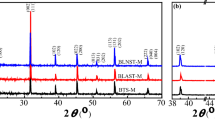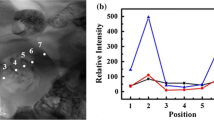Abstract
A series of acceptor-doped ceramics based on the solid solution, (1-x)BaTiO3–xBi(Zn1/2Ti1/2)O3 (BT-BZT), where x = 0.1, 0.2, 0.3, 0.4, were prepared via solid-state synthesis to investigate the effect of do** and BZT content on conduction properties. Impedance spectroscopy measurements showed an increase in conductivity through acceptor do** with Mg on the Ti-site (\({\text{Mg}}_{{{\text{Ti}}}}^{^{\prime\prime}}\)). Ceramics of the composition, 0.80BaTiO3–0.20Bi(Zn1/2Ti1/2)O3 with 3 mol% \({\text{Mg}}_{{{\text{Ti}}}}^{^{\prime\prime}}\), showed the highest conductivity in this study at 1.28 mScm−1 (~ 600 °C), an order of magnitude improvement over the stoichiometric composition. Variable pO2 impedance measurements revealed p-type conductivity in the grain while EMF measurements showed that above ~ 550 °C, ions are the dominant charge carriers (transference number, ti = 0.91 at 735 °C). Similarly, all 3 mol% Mg-doped compositions above x = 0.1 were primarily ionic conductors with transference numbers above ti = 0.79 (735 °C). X-ray diffraction data showed a pseudocubic primary phase for all samples with evidence of additional impurity phases accompanying samples with 3 mol% \({\text{Mg}}_{{{\text{Ti}}}}^{^{\prime\prime}}\) or greater.






Similar content being viewed by others
References
Beuerlein MA, Kumar N, Usher TM et al (2016) Current understanding of structure–processing–property relationships in BaTiO3–Bi(M)O3 dielectrics. J Am Ceram Soc 99:2849–2870. https://doi.org/10.1111/jace.14472
Kumar N, Cann DP (2016) Tailoring transport properties through nonstoichiometry in BaTiO3–BiScO3 and SrTiO3–Bi(Zn1/2Ti1/2)O3 for capacitor applications. J Mater Sci 51:9404–9414. https://doi.org/10.1007/s10853-016-0186-z
Li L, Li M, Zhang H et al (2016) Controlling mixed conductivity in Na1/2Bi1/2TiO3 using A-site non-stoichiometry and Nb-donor do**. J Mater Chem C 4:5779–5786. https://doi.org/10.1039/c6tc01719c
Li M, Pietrowski MJ, De Souza RA et al (2014) A family of oxide ion conductors based on the ferroelectric perovskite Na0.5Bi0.5TiO3. Nat Mater 13:31–35. https://doi.org/10.1038/nmat3782
Prasertpalichat S, Schmidt W, Cann DP (2016) Effects of A-site nonstoichiometry on oxide ion conduction in 0.94Bi0.5Na0.5TiO3–0.06BaTiO3 ceramics. J Adv Dielectr 06:1650012. https://doi.org/10.1142/S2010135X16500120
Jaffe B, Cook WR, Jaffe H (1971) Piezoelectric ceramics. Acad Press, Cambridge, p 328
Kishi H, Mizuno Y, Chazono H (2003) Base-metal electrode-multilayer ceramic capacitors: past, present and future perspectives. Jpn J Appl Phys 42:1–5. https://doi.org/10.1143/JJAP.42.1
Rödel J, Webber KG, Dittmer R et al (2015) Transferring lead-free piezoelectric ceramics into application. J Eur Ceram Soc 35:1659–1681. https://doi.org/10.1016/j.jeurceramsoc.2014.12.013
Raengthon N, Sebastian T, Cumming D et al (2012) BaTiO3-Bi(Zn1/2Ti1/2)O3- BiScO3 ceramics for high-temperature capacitor applications. J Am Ceram Soc 95:3554–3561. https://doi.org/10.1111/j.1551-2916.2012.05340.x
Kumar N, Patterson EA, Frömling T et al (2016) Conduction mechanisms in BaTiO3–Bi(Zn1/2Ti1/2)O3 ceramics. J Am Ceram Soc 99:3047–3054. https://doi.org/10.1111/jace.14313
Kumar N, Cann DP (2015) Resistivity enhancement and transport mechanisms in (1–x)BaTiO3–xBi(Zn1/2Ti1/2)O3 and (1–x)SrTiO3–xBi(Zn1/2Ti1/2)O3. J Am Ceram Soc 98:2548–2555. https://doi.org/10.1111/jace.13666
Kumar N, Patterson EA, Frömling T, Cann DP (2016) DC-bias dependent impedance spectroscopy of BaTiO3-Bi(Zn1/2Ti1/2)O3 ceramics. J Mater Chem C 4:1782–1786. https://doi.org/10.1039/c5tc04247j
Kumar N, Golledge SL, Cann DP (2016) Synthesis and electrical properties of BaBiO3 and high resistivity BaTiO3–BaBiO3 ceramics. J Adv Dielectr 06:1650032. https://doi.org/10.1142/S2010135X16500326
Kumar N, Patterson EA, Fromling T et al (2017) Defect mechanisms in BaTiO3-BiMO3 ceramics. J Am Ceram Soc 101:2376–2390. https://doi.org/10.1111/jace.15403
Smyth D (2000) The defect chemistry of metal oxides. Oxford University Press, Oxford
Triamnak N, Yimnirun R, Pokorny J, Cann DP (2013) Relaxor characteristics of the phase transformation in (1–x)BaTiO3-xBi(Zn1/2Ti1/2)O3 perovskite ceramics. J Am Ceram Soc 96:3176–3182. https://doi.org/10.1111/jace.12495
Triamnak N, Brennecka GL, Brown-Shaklee HJ et al (2014) Phase formation of BaTiO3–Bi(Zn1/2Ti1/2)O3 perovskite ceramics. J Ceram Soc Japan 122:260–266. https://doi.org/10.2109/jcersj2.122.260
Patterson EA, Cann DP (2012) Relaxor to ferroelectric transitions in (Bi1/2Na1/2)TiO3–Bi(Zn1/2Ti1/2)O3 solid solutions. J Am Ceram Soc 95:3509–3514. https://doi.org/10.1111/j.1551-2916.2012.05320.x
Shannon RD (1976) Revised effective ionic radii and systematic studies of interatomic distances in halides and chalcogenides. Acta Cryst A32:751–767
Yang F, Li M, Li L et al (2017) Optimisation of oxide-ion conductivity in acceptor-doped Na0.5Bi0.5TiO3 perovskite: approaching the limit? J Mater Chem A 5:21658–21662. https://doi.org/10.1039/c7ta07667c
Raengthon N, Derose VJ, Brennecka GL, Cann DP (2012) Defect mechanisms in high resistivity BaTiO3-Bi(Zn1/2Ti1/2)O3 ceramics. Appl Phys Lett. https://doi.org/10.1063/1.4752452
Irvine JTS, Sinclair DC, West AR (2016) Electroceramics: characterization by impedance spectroscopy. Adv Mater 21:132–138. https://doi.org/10.1002/chin.199026349
Sinclair DC (1995) Characterization of electro-materials using ac impedance spectroscopy. Bol la Soc Esp Cerám y Vidr 34:55–65
Yoo HI, Song CR (2000) Defect structure and chemical diffusion in BaTiO3-δ. Solid State Ionics 135:619–623. https://doi.org/10.1016/S0167-2738(00)00420-3
Jun YW, Lee J-H, Choi J, Cheon J (2017) BaTiO3−δ: defect structure, electrical conductivity, chemical diffusivity, thermoelectric power, and oxygen nonstoichiometry. J Phys Chem B 52:668–677
Li M, Zhang H, Cook SN et al (2015) Dramatic influence of A-site nonstoichiometry on the electrical conductivity and conduction mechanisms in the perovskite oxide Na0.5Bi0.5TiO3. Chem Mater 27:629–634. https://doi.org/10.1021/cm504475k
Long C, Du T, Ren W (2020) Significant ion conduction in Cu acceptor-substituted bismuth titanate polycrystalline ceramics. J Mater Sci 55:5715–5729. https://doi.org/10.1007/s10853-020-04431-x
Meyer KC, Albe K (2017) Influence of phase transitions and defect associates on the oxygen migration in the ion conductor Na1/2Bi1/2TiO3. J Mater Chem A 5:4368–4375. https://doi.org/10.1039/c6ta10566a
Van Laethem D, Deconinck J, Hubin A (2019) Ionic conductivity of space charge layers in acceptor doped ceria. J Eur Ceram Soc 39:432–441. https://doi.org/10.1016/j.jeurceramsoc.2018.08.046
De Souza RA (2015) Oxygen diffusion in SrTiO3 and related perovskite oxides. Adv Funct Mater 25:6326–6342. https://doi.org/10.1002/adfm.201500827
Acknowledgements
This material is based upon work supported by the National Science Foundation under Grant No. DMR-1832803.
Author information
Authors and Affiliations
Corresponding authors
Ethics declarations
Conflict of interest
The authors declare that they have no conflict of interest.
Additional information
Handling Editor: Kevin Jones.
Publisher's Note
Springer Nature remains neutral with regard to jurisdictional claims in published maps and institutional affiliations.
Rights and permissions
About this article
Cite this article
McQuade, R.R., Mardilovich, P., Kumar, N. et al. Conduction properties of acceptor-doped BaTiO3–Bi(Zn1/2Ti1/2)O3-based ceramics. J Mater Sci 55, 16290–16299 (2020). https://doi.org/10.1007/s10853-020-05175-4
Received:
Accepted:
Published:
Issue Date:
DOI: https://doi.org/10.1007/s10853-020-05175-4




